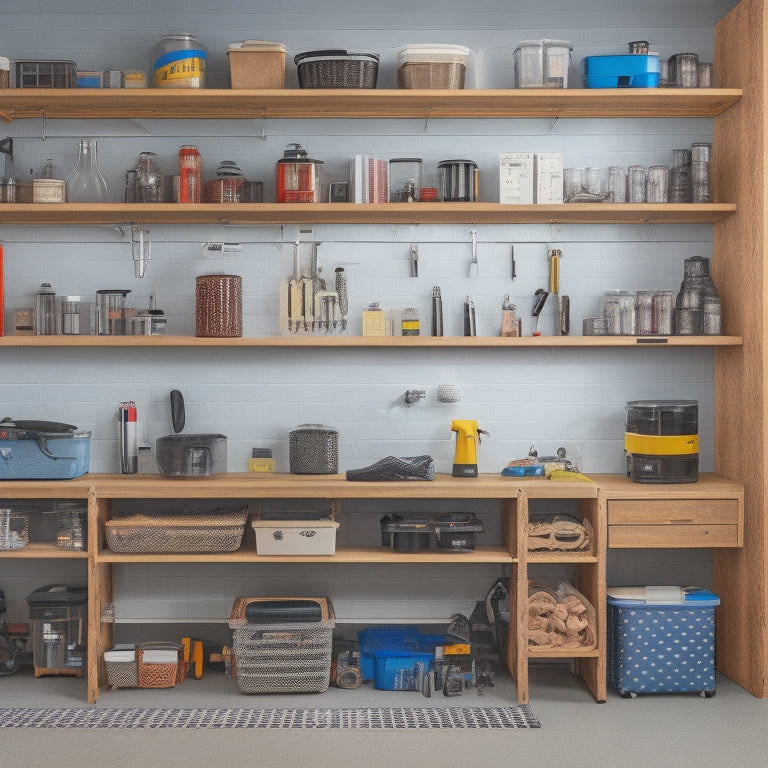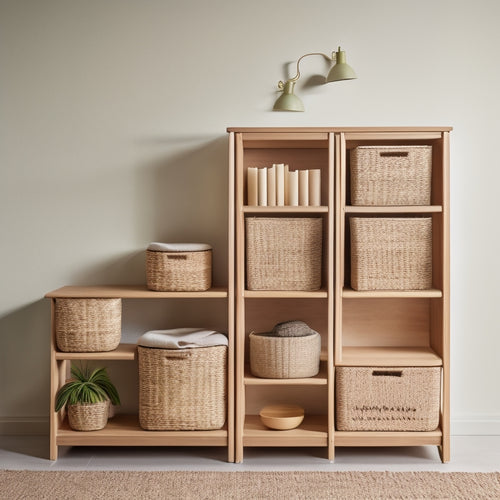
How to Build and Mount Wall Mounted Garage Storage
Share
You're about to change your garage into a tidy and functional space by building and mounting wall-mounted garage storage that effectively organizes your belongings and maximizes available space. Start by selecting the right materials, such as 3/4-inch plywood or MDF for shelves, and 2x4 or 2x6 lumber for the frame. Assess your storage needs, design your system, and cut and assemble shelves accordingly. Prepare the wall by measuring, marking, and filling imperfections. Install mounting hardware, attach storage units, and perform a final check for stability and weight capacity. As you progress, you'll uncover the complexities of creating a customized storage solution that perfectly suits your garage's unique needs.
Key Takeaways
- Choose the right materials, considering weight capacity, frame construction, and aesthetic appeal to ensure a sturdy and visually appealing storage system.
- Assess storage needs, identifying key areas for tools, seasonal items, and bulky equipment, and categorize items by frequency of use.
- Cut and assemble shelves accurately, preparing the wall by cleaning, inspecting, and priming the surface for reliable mounting.
- Measure and mark the wall correctly, identifying wall type, locating studs, and maintaining consistent spacing between shelves.
- Install mounting hardware securely, following manufacturer's instructions, and attach storage units levelly and evenly spaced for stability.
Choosing the Right Materials
When it comes to building wall-mounted garage storage, selecting the right materials is crucial to secure durability, stability, and aesthetic appeal.
You'll want to choose materials that can withstand the weight capacity you need, taking into account the items you plan to store.
For the shelves, you'll need a sturdy material like 3/4-inch plywood or medium-density fiberboard (MDF). These material types can support heavy loads and are resistant to warping or sagging.
Avoid using thin plywood or oriented strand board (OSB) as they may not provide the necessary weight capacity.
For the frame, you can use 2x4 or 2x6 lumber, depending on the size of your storage system. Make certain to choose lumber that's straight, dry, and free of knots to guarantee stability.
You'll also need screws, nails, or brackets to assemble the frame and attach it to the wall.
Remember to take into account the finish and color of your materials to guarantee they match your garage's aesthetic.
With the right materials, you'll be able to build a safe and functional wall-mounted garage storage system that meets your needs.
Designing Your Storage System
You'll need to assess your storage needs by making a list of the items you want to store, including their sizes and frequencies of use.
Next, identify key storage areas, such as zones for frequently used tools, infrequently used seasonal items, and bulky equipment.
Assess Your Storage Needs
Designing an effective wall-mounted garage storage system begins with a thorough assessment of your storage needs. You must identify what you want to store, how often you'll access it, and the available space on your walls.
Take inventory of your garage's contents, including tools, sports equipment, seasonal decorations, and other items. Consider the frequency of use and categorize items into three groups: daily, weekly, and occasional use.
Next, measure your garage walls, taking note of any obstacles such as windows, doors, and electrical outlets. Consider the weight and size of the items you need to store, as well as any specific storage solutions required, like bins, baskets, or hooks.
Think about the organizing tips that will work best for your space, such as grouping similar items together or using vertical storage to maximize space.
Identify Key Storage Areas
Your garage's layout and available wall space dictate the placement of key storage areas. To optimize your wall-mounted garage storage, you need to identify the areas that require the most storage.
Consider the zones where you spend most of your time, such as the workspace, parking area, and entryway.
In the workspace, you'll likely need storage for frequently used tools and equipment. Organizing tools in this area will help you maximize efficiency and reduce clutter.
Consider installing shelves, cabinets, or pegboards to hold items like power tools, hand tools, and accessories.
In the parking area, you may want to designate storage for items like bikes, sports equipment, or seasonal decorations. This will help keep the floor clear and prevent tripping hazards.
For the entryway, consider storage for personal items like backpacks, coats, and shoes.
Optimize Space Allocation
The garage's spatial constraints demand a deliberate approach to allocating storage space. You'll need to maximize every inch to create a functional and organized garage. To optimize space allocation, consider the following factors:
| Storage Type | Benefits | Ideal Placement |
|---|---|---|
| Vertical Storage | Maximize ceiling height, reduce floor clutter | Near frequently used tools and equipment |
| Multi-Purpose Shelves | Store various items, adjust shelf heights | Above workbenches or near frequently used tools |
| Sliding Bins | Easy access, conceal contents | Below shelves or near frequently used tools |
| Hooks | Hang bulky items, free up floor space | Near frequently used tools and equipment |
| Cabinets | Secure storage, protect important items | Near workbenches or in corners |
When designing your storage system, prioritize frequently used items and place them at eye level or near your primary work area. Less frequently used items can be stored on higher or lower shelves. By allocating space thoughtfully, you'll create a safe and efficient garage that meets your specific needs.
Cutting and Assembling Shelves
You'll need to contemplate the shelf design carefully, bearing in mind the type of items you'll be storing, their weight, and the space available on your wall.
Next, measure your shelves accurately, using a tape measure or caliper to guarantee precise cuts, and then cut your shelves to size using a circular saw or jigsaw.
With your shelves cut, you can begin assembling them, using screws or nails to attach the shelf boards to the shelf frames.
Shelf Design Considerations
Precision is key when designing shelves for your wall-mounted garage storage, as it directly impacts the overall functionality and durability of the system. You'll want to evaluate both shelf aesthetics and load capacity to guarantee your shelves meet your needs and can handle the weight of your stored items.
When designing your shelves, evaluate the following factors:
| Design Factor | Considerations |
|---|---|
| Shelf Material | Choose a material that can support the weight of your items, such as 3/4" plywood or MDF. |
| Shelf Thickness | A minimum of 3/4" thickness is recommended for most garage storage needs. |
| Shelf Spacing | Space shelves 12-18 inches apart to accommodate most storage bins and baskets. |
| Shelf Edge | Use a 1-2 inch edge to prevent items from falling off and to provide a secure surface for storage bins. |
Measuring and Cutting
With your shelf design finalized, it's time to bring your plans to life by measuring and cutting the shelves. To guarantee accurate cuts, gather your measuring tools, including a tape measure, square, and calipers. Double-check your measurements against your design plans to avoid errors.
When measuring, consider the thickness of the shelves, as well as any obstructions, such as outlets or studs.
Choose the appropriate cutting techniques based on the type of material you're working with. For wood, use a circular saw or miter saw for straight cuts, and a jigsaw for curved cuts. For metal, use a metal-cutting saw or a band saw.
Always wear safety glasses and a dust mask when cutting, and keep loose clothing and long hair tied back. Cut on a stable, flat surface, and use a push stick or other safety device to keep your hands away from the blade.
Make clean, precise cuts, and label each shelf as you cut it to avoid confusion during assembly.
Preparing the Wall for Mounting
Mounting your garage storage system requires a sturdy and secure attachment to the wall, which can only be achieved by properly preparing the surface. This vital step guarantees a reliable and long-lasting installation.
Start by cleaning the wall thoroughly to remove dirt, grime, and old adhesive residue. Use a degreaser or a mixture of soap and water to wipe down the area, paying attention to any cracks or crevices.
Next, inspect the wall for any damaged or loose drywall, and repair or replace it as needed. Fill in any holes or dents with spackling compound, sand it smooth, and apply a coat of primer if necessary. This will create a solid foundation for your storage system.
Measuring and Marking the Wall
Your garage wall is now ready for measurement and marking, an essential step in guaranteeing your storage system is installed accurately and securely.
Begin by identifying the type of wall you're working with, as this will affect the measurement and marking process. Drywall, plywood, and oriented strand board (OSB) are common wall types found in garages.
Using a stud finder, locate the wall studs behind the drywall or other finish material. Typically, studs are spaced 16 inches on-center, but this can vary depending on the construction of your garage. Mark the stud locations with a pencil, taking care to identify any electrical outlets, switches, or other obstacles that may interfere with your storage system.
Next, measure the width of your storage system components, including shelves, cabinets, and hooks. Transfer these measurements to the wall, using a level to guarantee accurate marking.
Pay close attention to the location of studs, as you'll want to anchor your storage system to these points for maximum stability and support.
With your wall measured and marked, you're now ready to proceed with the installation process.
Installing the Mounting Hardware
Stability is the foundation of a successful garage storage system, and it all begins with the installation of mounting hardware. You've measured and marked the wall, now it's time to secure the mounting hardware that will support your storage units.
Choose from a variety of hardware options, such as lag screws, wall anchors, or molly bolts, depending on the type of wall and weight capacity required.
When selecting hardware, consider the weight of the storage units and the material of the wall. For example, if you have a heavy storage unit, you may need to use lag screws or molly bolts for added support. Always follow the manufacturer's instructions for specific mounting techniques and hardware requirements.
Proper installation is essential to guarantee the safety and stability of your garage storage system. Use a level to verify the hardware is straight, and a drill with a screwdriver bit to secure the screws.
Take your time and double-check your work to avoid any mistakes that could compromise the system's stability. By following these steps, you'll have a solid foundation for your wall-mounted garage storage system.
Attaching the Storage Units
With the mounting hardware securely in place, you're ready to attach the storage units. Make certain to follow the manufacturer's instructions for specific attachment requirements. Generally, you'll want to start by attaching the shelves, verifying they're level and evenly spaced. This is essential for shelf stability and weight distribution.
| Shelf Type | Attachment Method |
|---|---|
| Fixed Shelves | Screws or bolts into wall studs |
| Adjustable Shelves | Clips or brackets into wall anchors |
| Sliding Shelves | Rails or tracks attached to wall studs |
| Basket Shelves | Hooks or screws into wall anchors |
When attaching the shelves, verify they're securely fastened to the wall to prevent tipping or falling. Overloading the shelves can lead to catastrophic failure, so be mindful of the weight capacity. Distribute the weight evenly across the shelves, and consider adding support brackets for heavier items. Remember to test the storage units before loading them with heavy items to confirm they can withstand the weight.
Final Check and Adjustments
The garage storage system is now taking shape, and it's essential to perform a final check to confirm everything is in order.
Double-check that all screws, bolts, and nuts are securely tightened, and make sure that the system is level and plumb. Verify that the storage units are properly attached to the wall and can hold the intended weight.
-
Check the weight capacity of each storage unit and make sure it's not overloaded.
-
Verify that all moving parts, such as hinges and drawer slides, are properly lubricated and functioning smoothly.
-
Inspect the system for any signs of wear or damage, and perform any necessary maintenance or repairs.
Frequently Asked Questions
Can I Use Wall-Mounted Storage in a Garage With Uneven Walls?
You'll face installation challenges in a garage with uneven walls, but you can still use wall-mounted storage if you're willing to invest time in wall leveling, ensuring a secure and safe installation that won't compromise your storage system's stability.
How Do I Clean the Storage Units and Shelves Regularly?
You're finally organized, but don't get too comfortable - dust and dirt will find a way! Set a maintenance schedule and masterful cleaning techniques like gentle wiping, soft-bristled brushing, and occasional deep cleaning to keep your storage units and shelves in top shape.
Are Wall-Mounted Storage Systems Suitable for Heavy Tools and Equipment?
When choosing a wall-mounted storage system, you'll want to verify it's suitable for heavy tools and equipment by checking the weight capacity and material durability, as a failure can lead to serious accidents and injuries.
Can I Customize the Storage Units to Fit My Specific Needs?
Did you know 75% of garages are cluttered? You can create a personalized space by customizing storage units to fit your specific needs with custom shelving options and adjustable brackets, ensuring a safe and efficient storage solution.
How Do I Prevent the Storage Units From Sagging Over Time?
To prevent sagging, you'll want to guarantee proper load distribution by installing sturdy brackets, using reinforced materials, and evenly spacing storage units to distribute weight, thereby maintaining structural integrity and ensuring safe, long-term storage.
Conclusion
As you stand back to admire your handiwork, your garage renovation is complete. The once-cluttered space now shines like a polished gem, thanks to your wall-mounted storage system. You've tamed the chaos, corralling tools and supplies into neat, accessible rows. Your garage has become a sanctuary, a proof of your ingenuity and precision. Just as a skilled builder constructs a sturdy edifice, you've erected a fortress of organization, where every item has its designated place, and order reigns supreme.
Related Posts
-

Open Storage Bins for Shelving Units
You need open storage bins that integrate seamlessly with your shelving units to boost your organization, productivit...
-

Choosing the Right Stacked Storage Bins
When choosing the right stacked storage bins, you'll want to evaluate your storage needs, considering inventory types...
-

Top 5 Small Tool Organizers for Your Workshop
You're looking to optimize your workshop's efficiency with high-quality small tool organizers. Compact storage soluti...


